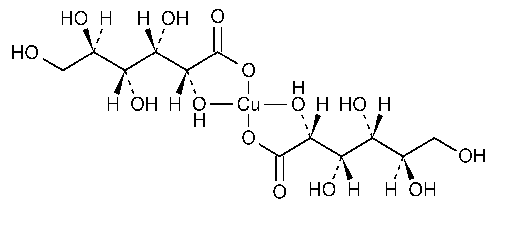Copper Gluconate
»Copper Gluconate contains not less than 98.0percent and not more than 102.0percent of C12H22CuO14.
Packaging and storage—
Preserve in well-closed containers.
Identification—
A:
Asolution (1in 20)responds to the test for Copper á191ñ.
Chloride á221ñ—
A1.0-g portion shows no more chloride than corresponds to 1mLof 0.020Nhydrochloric acid (0.07%).
Sulfate á221ñ—
A2.0-g portion dissolved in boiling water shows no more sulfate than corresponds to 1mLof 0.020Nsulfuric acid (0.05%).
Arsenic,Method Iá211ñ—
Dissolve 1.0g in 35mLof water:the limit is 3ppm.
Lead—
[NOTE—For the preparation of all aqueous solutions and for the rinsing of glassware before use,employ water that has been passed through a strong-acid,strong-base,mixed-bed ion-exchange resin before use.Select all reagents to have as low a content of lead as practicable,and store all reagent solutions in containers of borosilicate glass.Cleanse glassware before use by soaking in warm 8Nnitric acid for 30minutes and by rinsing with deionized water.]
Standard preparation—
Transfer 10.0mLof Lead Nitrate Stock Solution,prepared as directed in the test for Heavy Metals á231ñ,to a 100-mLvolumetric flask,add 40mLof water and 5mLof nitric acid,dilute with water to volume,and mix.Transfer 0.40mLof this solution to a second 100-mLvolumetric flask,add 50mLof water and 1mLof nitric acid,dilute with water to volume,and mix.This solution contains 0.04µg of lead per mL.
Test preparation—
Transfer about 4g of Copper Gluconate,accurately weighed,to a 100-mLvolumetric flask.Add 50mLof water and 5mLof nitric acid,and sonicate to dissolve the specimen.Dilute with water to volume,and mix.Transfer 4.0mLof this solution to a second 100-mLvolumetric flask,add 50mLof water and 1mLof nitric acid,dilute with water to volume,and mix.
Blank—
Transfer 1.2mLof nitric acid to a 100-mLvolumetric flask,dilute with water to volume,and mix.
Test solutions—
Prepare mixtures of the Test preparation,the Standard preparation,and the Blankwith the following proportional compositions,by volume:10.0:0:10.0,10.0:4.0:6.0,10.0:7.0:3.0,and 10.0:10.0:0.These Test solutionscontain,respectively,0,0.008,0.014,and 0.020µg per mL,of lead from the Standard preparation.
Procedure—
Separately inject equal volumes (about 20µL)of the Test solutionsand the Blankinto the graphite tube of a suitable graphite furnace atomic absorption spectrophotometer,temperature-programmed as follows to reach 2000 in about 2minutes,using an argon gas flow of about 3Lper minute,except where indicated:70
in about 2minutes,using an argon gas flow of about 3Lper minute,except where indicated:70 for 10seconds,90
for 10seconds,90 for 60seconds,120
for 60seconds,120 for 15seconds,250
for 15seconds,250 for 5seconds (no gas flow),250
for 5seconds (no gas flow),250 for 10seconds,250
for 10seconds,250 for 2seconds (no gas flow),and 2000
for 2seconds (no gas flow),and 2000 for 3.2seconds.When the temperature reaches 2000
for 3.2seconds.When the temperature reaches 2000 ,determine the absorbance at the lead emission line at 283.3nm,corrected for background absorption.Correct the absorbance values obtained from the Test solutionsby subtracting from each the absorbance value obtained from the Blank.Plot the corrected absorbances of the Test solutionsversus their contents of lead,in µg per mL,as furnished by the Standard preparation,draw the straight line best fitting the four points,and extrapolate the line until it intercepts the concentration axis.From the intercept determine the concentration,C,in µg per mL,of lead in each mLof the test solution containing 0µg of lead from the Test preparation.Calculate the percentage of lead in the specimen taken by the formula:
,determine the absorbance at the lead emission line at 283.3nm,corrected for background absorption.Correct the absorbance values obtained from the Test solutionsby subtracting from each the absorbance value obtained from the Blank.Plot the corrected absorbances of the Test solutionsversus their contents of lead,in µg per mL,as furnished by the Standard preparation,draw the straight line best fitting the four points,and extrapolate the line until it intercepts the concentration axis.From the intercept determine the concentration,C,in µg per mL,of lead in each mLof the test solution containing 0µg of lead from the Test preparation.Calculate the percentage of lead in the specimen taken by the formula:
0.5C/W,
in which Wis the weight,in g,of Copper Gluconate taken to prepare the Test preparation:the limit is 0.0025%.
Reducing substances—
Transfer 1.0g to a 250-mLconical flask,dissolve in 10mLof water,and add 25mLof alkaline cupric citrate TS.Cover the flask,boil gently for 5minutes,accurately timed,and cool rapidly to room temperature.Add 25mLof 0.6Nacetic acid,10.0mLof 0.1Niodine VS,and 10mLof 3Nhydrochloric acid,and titrate with 0.1Nsodium thiosulfate VS,adding 3mLof starch TSas the endpoint is approached.Perform a blank determination,omitting the specimen,and note the difference in volumes required.Each mLof the difference in volume of 0.1Nsodium thiosulfate consumed is equivalent to 2.7mg of reducing substances (as dextrose):the limit is 1.0%.
Assay—
Dissolve about 1.5g of Copper Gluconate,accurately weighed,in 100mLof water.Add 2mLof glacial acetic acid and 5g of potassium iodide,mix,and titrate with 0.1Nsodium thiosulfate VSto a light yellow color.Add 2g of ammonium thiocyanate,mix,add 3mLof starch TS,and continue titrating to a milk-white endpoint.Each mLof 0.1Nsodium thiosulfate is equivalent to 45.38mg of C12H22CuO14.
Auxiliary Information—
Staff Liaison:Lawrence Evans,III,Ph.D.,Scientist
Expert Committee:(DSN)Dietary Supplements:Non-Botanicals
USP28–NF23Page 544
Phone Number:1-301-816-8389
